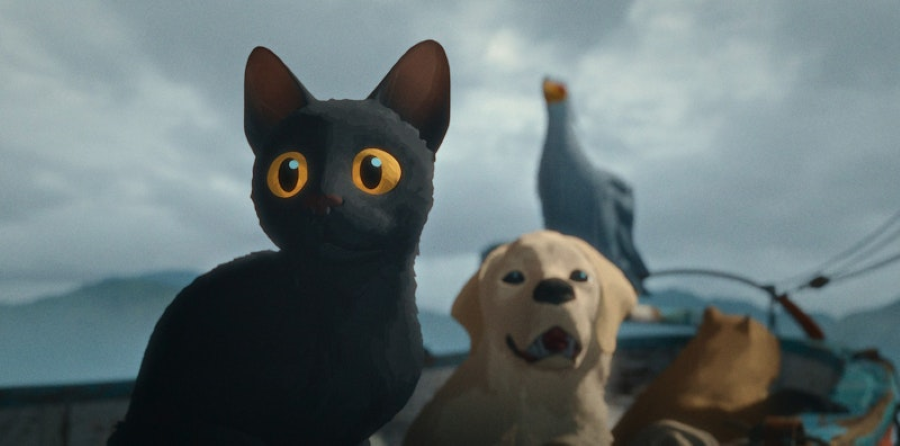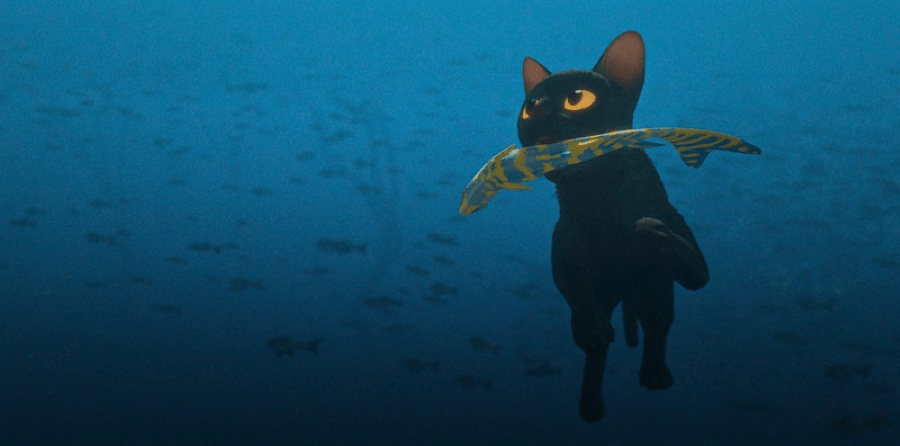Virtually anywhere on Earth, disaster is just a random collision of weather patterns away from your doorstep. A hurricane could tear off your roof, a wildfire might burn through your neighborhood, or a storm could flood your town, sweeping away cars, buildings, and utility poles alike. When the worst happens, how will you respond?
The animated feature Flow asks its viewers to reflect on such distressing questions in the subtle way that narrative films are so well suited for. The movie follows a black cat and the small menagerie of animals it meets as they sail over a drowned landscape, encountering survivors amid abandoned cities. And while each animal relies on instinct to pull through, the story follows a few that are able to overcome their me-first instinct to stick together.
The film pairs the charm of authentically animal-like characters with a simplistic 3D animation style — an unusual combo for feature-length films. It’s no wonder the Latvian film, made by the director Gints Zilbalodis on a modest $3.7 million budget, managed to shift a Hollywood paradigm: In January, Flow nabbed a Golden Globe for Best Animated Feature, beating out movies from Disney/Pixar, DreamWorks, and the Wallace and Gromit franchise. Now the film is nominated for two Academy Awards on March 2: Best Animated Feature and Best International Feature. No Latvian film has ever been nominated for either award before — let alone won.
It’s rare for independent animation to break into the mainstream. Even films by award-nominated artists, such as It’s Such a Beautiful Day (2011) by Don Hertzfeldt and Anomalisa (2015) by Charlie Kaufman and Duke Johnson, languish in festival circuits and are often too short on manpower, budget, and time. Laika, a small stop-motion animation house responsible for better-known features like Coraline (2009) and Kubo and the Two Strings (2016), each made on a $60 million budget, didn’t manage to win a Golden Globe in the animation category until 2019, with Missing Link. Foreign films face even more barriers: Studio Ghibli, the acclaimed Japanese animation studio behind Totoro (1988), has won an Academy Award for best animated feature only once, for Spirited Away in 2003. Two decades later, the studio’s most recent film, The Boy and the Heron (2023), received its only Golden Globe nomination and award for best animated feature.
In spite of all this, Flow takes up the space of a feature film with confidence and introduces the cat’s daily routine in an indulgent 15-minute sequence before floodwaters begin driving the action, allowing the viewer to delight in the cat’s charming, realistic mannerisms, and get a sense of what will soon be lost. (Be warned: spoilers ahead.)

Janus Films
While humans are no longer found in the world of Flow, the setting of familiar-yet-fantastic ruins suggests that a flood has happened before, that there was a calamity before the one that’s about to swallow what remains. The cat lives in a house that was seemingly once the home of a human who either worshiped or obsessed over cats, replete with charcoal drawings and sculptures of them. The rising water soon submerges the house, its artifacts, and eventually everything. It’s a mirror to the equalizing power of natural disasters: Nothing is safe, not even our idols.
The nature of the flood seems to straddle the line between biblical fable and real-world climate disaster. Within a day or so after the first powerful wave, the cat is forced to climb to the tallest point in the landscape, which happens to be a giant cat statue. Just as our protagonist’s paws start to get wet, a boat passes by with a capybara onboard. Eventually, the pair pick up a self-sacrificing secretary bird, a trinket-obsessed lemur, and an eager-to-please labrador.
Flow isn’t necessarily compelling because of its depiction of disaster, but because of its portrayal of how these animals respond to it. In interviews, Zilbalodis has said the inspiration came from a short film he made while in high school about cats’ fear of water. “I really wanted to focus on the relationship between the animals, about the fear of others,” he told The Hollywood Reporter. “The water is basically a way to communicate those other fears.”
As the water rises, the animals’ interactions change — but not how you might expect. Flow’s cast of characters don’t adopt the usual human habits and personalities, exaggerated features, and over-the-top movements that come with the animation territory — from the dancing cabaret in The Lion King (1994) to the career bunny-cop star of Zootopia (2016). It’s been the go-to move as long as animated films have been around, starting in the early 20th century with Mickey Mouse’s debut in Steamboat Willy (1928) and the noodly “rubberhose” style of the time. Ladislas Starevich, a naturalist (and arguably the first stop-motion animator) who puppeted exoskeletons of beetles for his films, depicted his subjects dining at restaurants, writing letters, and carrying briefcases in a story about a martial dispute in 1912.
Flow takes a different approach. The animals communicate with each other through meows, chitters, woofs, and grunts as animals really do. Each moves with striking realism and personalities largely true to their expected biological nature. (Cat owners are likely to think, “Oh, that’s exactly how my Miss Mittens acts!”) By keeping the animals so endearingly like their real-life counterparts, Zilbalodis is able to highlight the differences in their instincts.
And it’s the moments when these dispositions clash that drive the story forward. When the cat eventually overcomes its fear of water to provide fish for its companions, the good faith is quickly shattered when a self-interested dog devours most of the supply. Worse, the dog was only on board because of the other animals’ kindness: Minutes before, they had saved the dog and its unruly pack from rising waters.
“I didn’t want to have this didactic message of: Working together is good and being independent is bad,” Zilbalodis told the Hollywood Reporter. “I wanted to show the good and the bad of both of these extremes.”

Janus Films
Even in an industry where 3D animation has become the norm, Flow visually stands out. Most animation studios, like Pixar and Dreamworks, use proprietary, cutting-edge software designed for feature film animation. Flow, however, was animated in Blender, a free 3D modeling engine popular with video game developers. The low-budget option doesn’t detract from the experience. Rather, its resemblance to a video game cut scene keeps you in anticipation, as if a moment of decision-making might be around the corner. It’s an impulse that clashes with the helplessness that disaster brings: Each time the cat nearly drowns, you just want to reach out and pluck it from the water.
The flood miraculously retreats and reveals a lush landscape for the animals to return to. It’s a comfort afforded to a fantasy world: When Earth’s seas reclaim the shorelines, the land won’t return in a matter of days, or even lifetimes. At the end of the film, the animals are met with another test of their comradery. They all survive, but the atmosphere becomes quickly subdued. The boat that has kept them safe plunges into the bottom of a ravine, while the receding waters leave a whale-like creature that protected the crew throughout the film beached and struggling to breathe. It’s a reminder that even in the best possible climate outcome, there will be plenty to mourn.
This story was originally published by Grist with the headline How do you survive the end of the world? Oscar-nominated ‘Flow’ offers an answer—through the eyes of a cat on Feb 24, 2025.
An indie animated movie from Latvia with no humans or dialogue might be the best climate movie of the year Culture Grist





